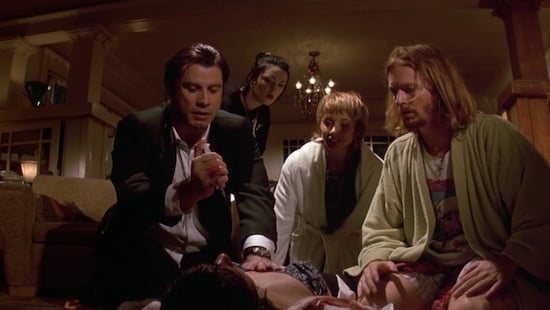Shocking Blocking (49)
By:
June 9, 2013

Once hit man Vincent (John Travolta) carries comatose gangster moll Mia (Uma Thurman) into drug dealer Lance’s (Eric Stoltz) living room, Pulp Fiction begins to pay homage not to other movies, but to TV. Even without the vintage boardgames and retro furnishings, we’d recognize this scenario — the beat-up couch facing the television; the bickering family members, roommates, and neighbors who seem to spend every moment therein — as the locus of a 1970s sitcom: Laverne & Shirley, perhaps, or Good Times. Tarantino’s all-encompassing use of cinematic homage and pastiche has led critics to name this the first wholly postmodern movie and “the final triumph of postmodernism”: a play of surfaces with no depth, i.e., no meaning. The blocking in this scene, however, does convey a message: the moviegoer’s escapism trumps the couch potato’s! Watching TV turns you into a neurasthenic, agoraphobic, brainless drone: Tarantino is critical of Lance and Jody’s (Rosanna Arquette) state of undress, not to mention Trudi’s (Bronagh Gallagher) death-grip on the bong. The TV-damaged slackers gather around the cinematic Vincent and Mia, not horrified but fascinated; movie escapism, by contrast to their own TV escapism, is (in Lance’s words) “intense.”
An occasional series analyzing some of the author’s favorite moments in the positioning or movement of actors in a movie.
THIRTIES (1934–1943): It Happened One Night (1934) | The Man Who Knew Too Much (1934) | The Guv’nor (1935) | The 39 Steps (1935) | Young and Innocent (1937) | The Lady Vanishes (1938) | Mr. Smith Goes to Washington (1939) | The Big Sleep (1939) | The Little Princess (1939) | Gone With the Wind (1939) | His Girl Friday (1940)
FORTIES (1944–1953): The Diary of a Chambermaid (1946) | The Asphalt Jungle (1950) | The African Queen (1951)
FIFTIES (1954–1963): A Bucket of Blood (1959) | Beach Party (1963)
SIXTIES (1964–1973): For Those Who Think Young (1964) | Thunderball (1965) | Clambake (1967) | Bonnie and Clyde (1967) | Madigan (1968) | Wild in the Streets (1968) | Barbarella (1968) | Harold and Maude (1971) | The Mack (1973) | The Long Goodbye (1973)
SEVENTIES (1974–1983): Les Valseuses (1974) | Eraserhead (1976) | The Bad News Bears (1976) | Breaking Away (1979) | Rock’n’Roll High School (1979) | Escape from Alcatraz (1979) | Apocalypse Now (1979) | Caddyshack (1980) | Stripes (1981) | Blade Runner (1982) | Tender Mercies (1983) | Monty Python’s The Meaning of Life (1983)
EIGHTIES (1984–1993): Repo Man (1984) | Buckaroo Banzai (1984) | Raising Arizona (1987) | RoboCop (1987) | Goodfellas (1990) | Candyman (1992) | Dazed and Confused (1993) |
NINETIES (1994–2003): Pulp Fiction (1994) | The Fifth Element (1997)
OUGHTS (2004–13): Nacho Libre (2006) | District 9 (2009)
Joshua Glenn’s books include UNBORED: THE ESSENTIAL FIELD GUIDE TO SERIOUS FUN (with Elizabeth Foy Larsen); and SIGNIFICANT OBJECTS: 100 EXTRAORDINARY STORIES ABOUT ORDINARY THINGS (with Rob Walker).
